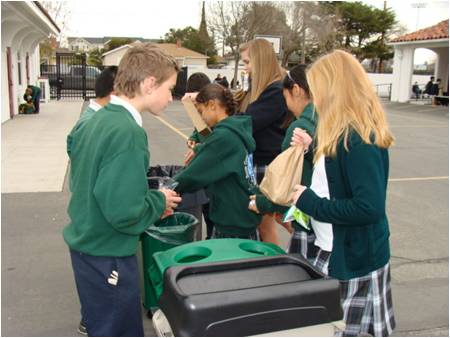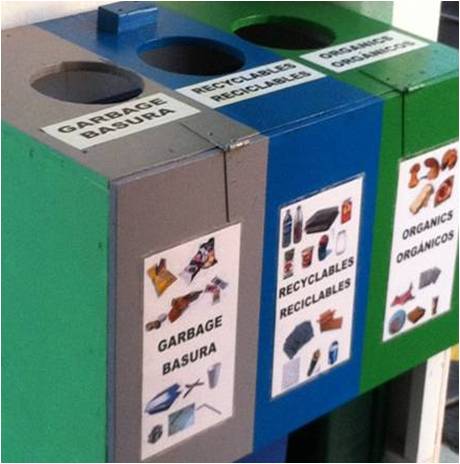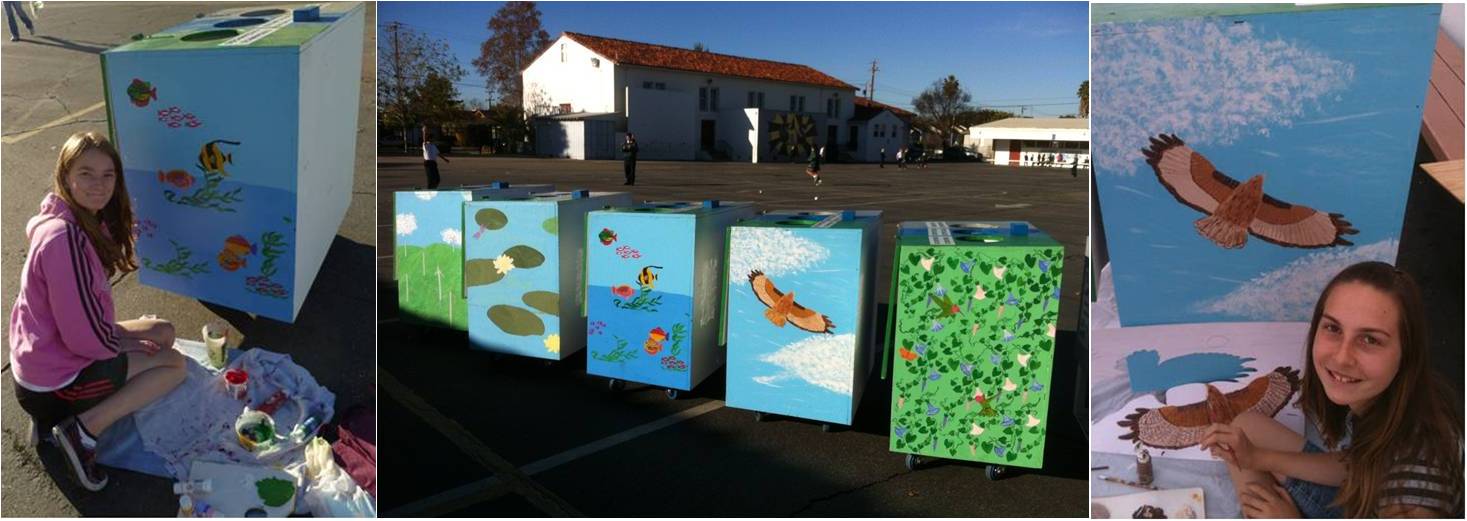 We have been amazed with the success of our school project to reduce waste. Students are working together to teach each other, their teachers, their parents, and community members about the importance of waste reduction, recycling and composting. The project has empowered students through leadership activities and given them a voice on campus.
We have been amazed with the success of our school project to reduce waste. Students are working together to teach each other, their teachers, their parents, and community members about the importance of waste reduction, recycling and composting. The project has empowered students through leadership activities and given them a voice on campus.
In just one year, we have reduced our trash removal costs by $1,200 and we are diverting approximately 40% of our waste from the landfill to composting and recycling centers.
When we formed an environmental club at St. Michael School in Livermore, CA, the students were eager to address the issue of waste on our campus. We received a PLT GreenWorks! grant, and students in grades 6 to 8 who form the school’s Earth Team implemented a “4R” program focused on reducing consumption, reusing products, recycling, and rotting.
Students Take the Lead
The Earth Team has flourished in the past 18 months and the direction of the team’s efforts has been driven by the students. We started by addressing recycling and the project has grown as the students became more aware.
To start, Earth Team students conducted a waste audit and established a plan to recycle cans, bottles, Capri Sun containers, candy wrappers, mixed-use paper, and other packaging materials. The team then tackled reducing the use of consumables on the school campus, reusing items, and composting yard clippings and food scraps.
The team kicked off the project with a school-wide assembly facilitated by Livermore Sanitation, our local waste collection company. During the assembly all students learned the basics of waste reduction.
 The Earth Team then set up waste collection bins in classrooms and around campus for proper sorting of waste. This project had many details that the students coordinated, including:
The Earth Team then set up waste collection bins in classrooms and around campus for proper sorting of waste. This project had many details that the students coordinated, including:
- Coordinating the colors with the dumpsters to avoid confusion.
- Designing posters to attach to the dumpsters, collection bins, and to post around the school.
- Translating Spanish posters and fliers to engage our Hispanic community in the project.
- Organizing teams of students to empty containers and to monitor and re-sort trash as needed.
- Pulling together reports for our weekly whole-school assembly.
- Writing tips for the school and for students to take home to their families.
The Earth Team took the lead on deciding when and how to educate the students, teachers, and staff at the school as they implemented each step of their plan.
Teachers in each classroom, from kindergarten to 6th grade, conducted lessons on environmental topics, including PLT activities such as Renewable or Not, The Forest of S.T. Shrew, Life on the Edge, and Pollution Search.
One of the activities students of all ages took part in was tracking their trash for a week. Some students conducted scientific experiments to get rid of trash (crush, burn, bury, tear, dissolve), and created a DVD skit about a family recycling. This comprehensive approach across the whole school has enhanced student learning in many ways.
Tips for Success
Get in touch with your waste collection company
One key part of our success was contacting our Public Education/Community Relations Manager at our waste collection company. Sheila Fagliano at Livermore Sanitation has been invaluable to us and has guided us along the way. She is just an email or phone call away when we need advice, assistance, or moral support.
Involve parents and community members
Involve parents and as many community members as possible. PG&E (our local gas and electric company), Zone 7 (our water district), Waste Management, and EEK (Environmental Education for Kids) are just a few of the many groups that have provided us with free educational materials and workshops.
Community organizations that use our campus now follow the students’ lead. For example, a community group that used to place cooking oil in the dumpster now takes it to a facility to be processed into biofuel.
The Girl Scouts took part in one of our projects. When the first wind storm blew our bins all over campus, we came up with a plan to build waste stations on wheels. These stations prevent the bins from being blown around and the wheels make it easy to move them around campus to be emptied and to be used at events held on campus by the school, the parish, and the community. The Girl Scouts took on some of the cost and all of the labor involved in painting our waste stations that show different habitats.

Our Parent Teacher Group is very supportive and helped organize a rummage sale as part of the reuse component of our project. It included a craft station where kids made art projects out of things that would have ended up in the landfill
Get the principal’s support
When our principal publicly announced his support at a staff meeting, all the teachers in the school became committed to the project. One of the outcomes of this support is the reduction of printing materials. The school administration has moved newsletters, event calendars, and even parent and student handbooks online rather than send home paper copies each week.
Involve the custodial staff
It is also important to ask your custodial staff to participate and educate them about your project and its goals. Be sure that your project doesn’t make their job more difficult. We did our homework and made a proposal to the site director. He is now thrilled that we have reduced the school’s garbage bill by $1,200.
Take advantage of enthusiasm
A month into our project, a group of students working lunch came to an Earth Team member and said, “Shouldn’t we be composting the food scraps?” We hadn’t planned on implementing the 4R’s all at once, but since the interest and enthusiasm was there, we started collecting food scraps and other compostable items without delay.
Encourage students to teach others
Not everyone will be on board right away, but there will at least be a small group of students who are excited to work on these projects. Empower those students to be stewards of the Earth, and encourage them to teach others.
The knowledge and enthusiasm from even a small group of students can spread to an entire community. Just a few months into the project, one Earth Team member was appalled when the kitchen staff put all the trash into the closest dumpster during a community event. She politely explained how the whole process worked, and suggested the Earth Team put laminated strips on the tops of dumpsters, for example, “food scraps,” “no metal,” “cardboard,” etc. The students also put laminated posters in the kitchen with guidelines on how to properly sort waste.


